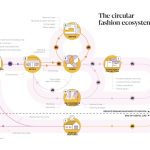Despite the cost of living crisis, new data from Idealo, a comparison site, highlights the ‘lipstick effect,’ where Brits continue to splurge on small luxuries like cosmetics, clothing, and sweet treats for comfort.
According to Idealo’s study on UK household spending, Brits are annually spending 6.4 billion pounds on cosmetics. However, spending on clothing is expected to decrease in 2023 to 8.2 billion pounds, down by 13 percent.
During the pandemic in 2020, women’s clothing expenditure peaked at 12.3 billion pounds, and men’s clothing spending reached 7.2 billion pounds. However, these numbers have since declined, with current average spending at 9.4 billion pounds for women’s clothes (33 percent less than 2020) and 5.3 billion pounds for men’s (37 percent less than 2020).
London and the South East lead in fashion spending, with Londoners annually spending 1.4 billion pounds on women’s clothes and 853.7 million pounds n men’s clothing. The study offers valuable insights into consumer behavior during times of economic uncertainty and hints at future beauty product expenditures by 2030.
London leads spending on fashion
Amidst shifting consumer patterns and the lingering impact of the pandemic, the data reveals that British spending on cosmetics remains robust, with an annual expenditure of 6.4 billion pounds. Despite a slight 7 percent decrease from the 6.9 billion pounds spent in 2020, this continued investment in beauty products showcases the enduring allure of small indulgences, especially during challenging times.
The regional breakdown of spending unveils intriguing disparities. London, being the frontrunner, showcases its penchant for beauty products, with an impressive annual expenditure of 983.6 million pounds. Not far behind, the South East follows suit with a substantial 892 million pounds, while the West Midlands allocates 653.5 million pounds to cosmetics. However, in stark contrast, Northern Ireland’s cosmetic spending stands at a relatively modest 171.9 million pounds, significantly lower (811.7 million pounds) than London’s expenditure.
Experts posit that the pandemic-induced lockdowns likely contributed to this shift in consumer behavior, with individuals seeking solace and comfort in small luxuries, including cosmetics, while confined to their homes.
The steady demand for cosmetics indicates a lucrative market that businesses can capitalise on, especially with evolving consumer preferences. As companies navigate the complexities of the post-pandemic landscape, understanding and catering to these subtle shifts in consumer behaviour will prove pivotal in seizing new opportunities.



